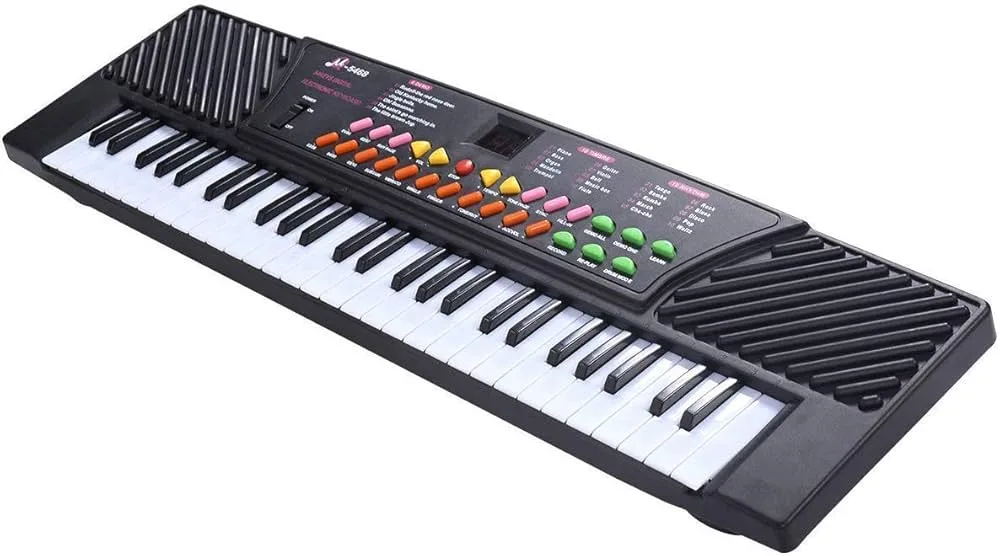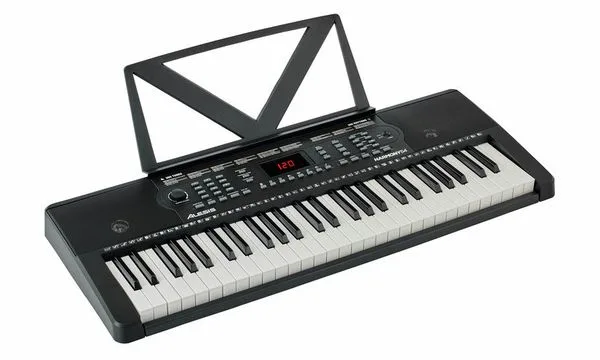Are you thinking about purchasing a piano but feeling overwhelmed by all the different sizes and options? Have you found yourself wondering, “Can a piano have 54 keys?” Well, you’ve come to the right place. As someone who has played and studied pianos for years, I understand how daunting it can be to find the perfect instrument. But fear not!
In this article, we’ll explore everything there is to know about piano sizes and help you determine if a 54-key piano is the right fit for your needs. Together, we’ll dive into factors such as cost, space requirements, skill level, and more to help make your decision easier. So let’s get started on finding the perfect size piano for you!
So, Can a piano have 54 keys?
A piano can have 54 keys. However, this is not the standard or most common size for a piano. The standard piano has 88 keys, with 52 white and 36 black keys. This allows for a wide range of notes to be played and creates a full sound.
Pianos with fewer than 88 keys are often referred to as “short keyboards” and are typically used by beginners or in smaller spaces where space is limited. They may also be used as practice instruments before transitioning to a full-sized piano.
While pianos with fewer than 88 keys may still produce beautiful music, they do have limitations in terms of the range of notes that can be played. It’s important to consider your goals and needs when choosing the right size piano for you.
Ultimately, whether you choose a piano with 54 keys or one with the standard 88 keys, what matters most is finding an instrument that suits your playing style and brings joy to your musical journey.
Understanding the Standard Sizes of Pianos
Pianos come in all shapes and sizes, which can make choosing the right one a bit tricky. Grand pianos, for example, are often associated with luxurious music halls and elegant living rooms. They range from about 4 feet 6 inches to over 9 feet long. The smallest grand piano is typically called a “baby grand,” while the largest is known as a “concert grand.” When you’re considering one of these beauties for your home or studio, remember that their size isn’t just about looks—larger pianos usually produce richer sound due to longer strings and bigger soundboards.
On the other hand, upright pianos are more compact but no less impressive. These vertical wonders generally stand between 3 feet 8 inches to around 5 feet tall. Their height impacts not only how much space they take up but also their tonal quality; taller uprights tend to have longer strings and larger soundboards, which contribute to better resonance. Whether it’s a spinet (the shortest kind), console, studio upright, or full-sized upright model you’re eyeing, knowing the standard sizes helps ensure it’ll fit perfectly into its intended nook without compromising on musical performance.
- Baby Grand: ~4’6″ – ~5’7″
- Parlor Grand: ~5’8″ – ~6’10”
- Semi-Concert Grand: ~6’11” – ~7′
- Concert Grand: Over 9′
- Spinet Upright: ~36″-~39″
- Console Upright: ~40″- ~44″
- Studio Upright :~45 “- ~48 “
- Full Sized Upright : Above 50 “
So next time you admire someone playing those ivory keys gracefully on any piano size, you ‘ll know there’s much more than meets the eye.
Assessing the Benefits and Limitations of a 54-Key Piano
A 54-key piano offers an intriguing balance between compact design and musical capability. One of the most attractive benefits of this smaller keyboard is its portability. Unlike a full-sized piano, which demands significant space, a 54-key version can fit into tighter quarters like small apartments or classrooms. This makes it an excellent choice for budding musicians who lack room for larger instruments. Additionally, many modern 54-key pianos come with advanced features such as built-in learning tools and connectivity options that cater to technology-savvy learners.
However, it’s important to recognize the limitations of a 54-key piano. While adequate for beginners, these fewer keys mean reduced range and versatility compared to standard keyboards with 88 keys. Advanced pieces often require those extra notes at either end of the spectrum, making it challenging to perform more complex compositions accurately on a smaller instrument.
- The limited key range may restrict repertoire selection.
- An experienced pianist might find it confining.
Despite these drawbacks, the lower cost generally associated with fewer keys could still make them appealing for hobbyists or children just starting their musical journey without breaking the bank.
Read also: used kawai upright piano price
Comparing Piano Costs: Standard Vs. 54-Key Pianos
When it comes to picking a piano for your musical journey, the price can make all the difference. Standard pianos, whether they are upright or grand, typically carry a heftier price tag. These instruments often feature full 88-key keyboards and offer superior sound quality due to their larger size and more complex construction. The craftsmanship involved in creating a standard piano is also far more intricate, involving high-quality materials like spruce wood for the soundboard and felt-covered hammers. These features contribute to both richer tones and greater durability but come at a cost that ranges from several thousand dollars to potentially tens of thousands.
On the other hand, 54-key pianos present an accessible alternative without entirely compromising on the experience. Designed with beginners in mind or those with limited space, these smaller keyboards are significantly cheaper. You can find them priced anywhere between $100-$500 depending on brand and additional features such as built-in learning modes or connectivity options like Bluetooth. Although they don’t offer the extensive range of notes found on an 88-key instrument and may lack some depth in tone quality, they still provide ample opportunity for practice and enjoyment without breaking the bank.
- Standard Pianos: High-quality materials; full 88 keys; rich tones.
- 54-Key Pianos: Affordable; beginner-friendly; compact design.
Choosing between these two ultimately depends on your needs—whether you’re aiming for professional-level play or simply looking for an entry point into music.

Space Requirements for Various Size Pianos
When thinking about placing a piano in your home, the first step is to consider how much space you have. Pianos come in different sizes, and each one needs its own amount of room to breathe and shine. Upright pianos, for example, are perfect for smaller spaces like apartments or cozy living rooms. They stand tall but don’t take up too much floor space. Most uprights need around 5 feet of width and just a few feet from the wall so they can resonate properly.
On the other hand, grand pianos need more elbow room and feel most at home in larger areas where their full sound can spread out beautifully. A baby grand still demands at least 6 feet by 9 feet of space to allow both the instrument itself and the player enough freedom to move comfortably. If you’re dreaming bigger with a concert grand piano, make sure you have about 10 feet by 14 feet available—it’s not just about fitting it into the room but ensuring that there’s ample distance for its acoustic magic to unfold fully.
- Upright Piano: Needs around 5 ft width
- Baby Grand Piano: Requires roughly 6×9 ft.
- Concert Grand Piano:: Demands at least a spacious area measuring approximately 10×14 ft.
No matter which kind of piano captures your heart, remember: giving it enough space will let its music echo magnificently through your home!
You may also like: Which guitarist use Yamaha
Matching Your Skill Level With The Right Sized Piano
Finding the right piano that matches your skill level is like finding a pair of shoes that fit perfectly. If you’re just starting out, there’s no need to jump straight into the deep end with a grand piano. An upright or digital keyboard can be an excellent choice. These instruments are often less intimidating and provide all the basics you need to grow as a pianist without overwhelming you. Digital keyboards are especially great because they typically come with features like headphone jacks for quiet practice, built-in metronomes, and even recording capabilities.
As your skills develop, you might start yearning for something more robust—a piano that offers richer tones and better touch sensitivity. This is when considering an acoustic upright or baby grand becomes worthwhile. With weighted keys, these pianos mimic the feel of larger concert grands but don’t take up as much room in your home. They also offer superior sound quality compared to digital alternatives and allow for greater expression in your playing.
When choosing any instrument:
- Feel: How does it respond to your touch?
- Tone: Does it resonate well with what you’d like to play?
- Size: Will it fit comfortably into its designated space?
Ultimately, aligning your current abilities with the appropriate piano type nurtures growth while keeping frustration at bay, giving every note you play its rightful place in the world of music.
Making an Informed Decision When Choosing a Piano Size
Choosing the right piano size can be a bit daunting, but it’s all about finding what suits your needs and space. If you’re just starting out or have limited room, an upright piano might be your best bet. These pianos stand tall and take up less floor space, making them ideal for apartments or smaller homes. On the other hand, if you’re lucky enough to have a spacious living area and are serious about sound quality, a grand piano could be perfect for you. Its larger soundboard and longer strings produce richer tones that fill the room with vibrant music.
However, it’s not just about size; think about how each type of piano fits into your lifestyle and budget.
Sound Quality: Grand pianos generally offer superior acoustics.
Space Considerations: Uprights fit better in tighter spots.
Aesthetics: Grands often become a stunning focal point.
In conclusion, when deciding on which piano to buy, consider both its physical dimensions as well as how it will complement your everyday life. Do you want something compact yet functional? Or do you desire an elegant instrument that enhances musicality? Balancing these factors ensures that you’ll make an informed decision tailored to your unique circumstances.

